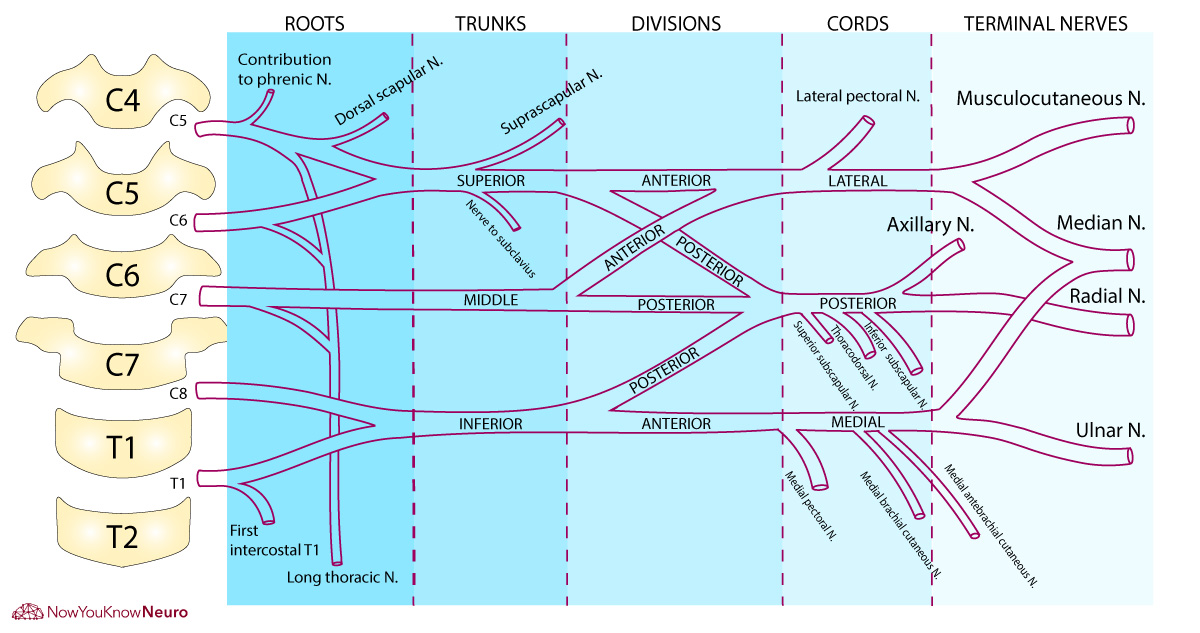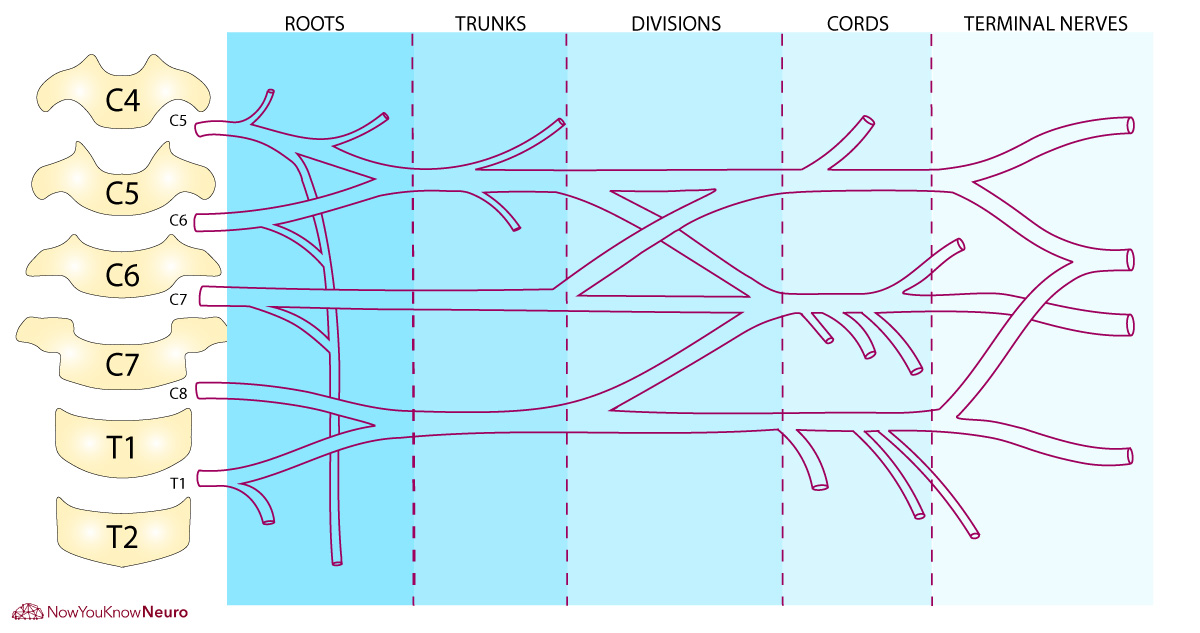The brachial plexus and innervation of the upper extremities are some of the first topics covered in the first year of medical school. Despite early exposure, physicians regularly rely on reference materials to refresh their memories. Unfortunately, Shelf, RITE*, and Board exams will not let you forget this material. In this chapter, we will discuss the basics of the brachial plexus and upper extremity nerves. Additionally, we will cover commonly seen brachial plexopathies and upper extremity neuropathies.
Authors: Brian Hanrahan MD, Parneet Grewal MD
Brachial Plexus
- The brachial plexus is a network of nerve fibers that relays the motor and sensory information of the upper limbs.
Brachial Plexus Diagram
Move the Slider to Practice!


- It is formed by the anterior rami of cervical spinal roots C5, C6, C7, C8, and T1.
- There are 5 sections of the brachial plexus; roots, trunks, divisions, cords, and lastly branches.
- Branches can be considered minor branches or terminal branches (see tables below).
Roots (C5, C6, C7, C8, T1)
- Anterior (motor) and posterior (sensory) roots contribute to the brachial plexus
- Once leaving the intervertebral foramina, roots merge to form three trunks in the neck.
Trunks
- Upper trunk (C5-C6)
- Middle trunk (C7)
- Lower trunk (C8-T1)
- Each trunk splits into anterior and posterior divisions.
Divisions
- Anterior divisions innervate flexor groups.
- Posterior divisions innervate extensor groups.
- Six divisions regroup to become three cords.
Cords
- Lateral cord (C5-C7) is formed from the anterior divisions of the upper and middle trunks.
- Medial cord (C8, T1) is the anterior division of the lower trunk.
- Posterior cord (C5-T1) is formed from the posterior divisions of all three trunks.
- Cords then terminate into terminal branches.
Branches
- Branches of roots
- Dorsal scapular nerve
- Long thoracic nerve
- Branches of trunks
- Suprascapular nerve
- Branches of the lateral cord
- Median nerve
- Musculocutaneous
- Lateral pectoral nerve
- Branches of the medial cord
- Median nerve
- Ulnar nerve
- Medial pectoral nerve
- Medial cutaneous nerve of the arm
- Medial cutaneous nerve of the forearm
- Branches of the posterior cord
- Radial nerve
- Axillary nerve
- Thoracodorsal nerve
- Subscapular nerve
Table 1: Minor branches of the brachial plexus
| Nerve (associated nerve root) | Muscle(s) and function |
| Dorsal Scapular nerve (C5) | Rhomboids: Elevation and adduction of scapula Levator scapulae: Elevation and medial rotation of scapula |
| Subclavian nerve (C5-C6) | Subclavian: Depression of the clavicle and elevation of first rib |
| Long thoracic nerve (C5-C7) | Serratus anterior: Stabilization of scapula against chest wall |
| Suprascapular nerve (C5-C6) | Supraspinatus: Shoulder abduction (first 15 degrees)
Infraspinatus: External rotation of arm |
| Subscapular nerves (C5-C7) | Upper → Subscapularis: Internal rotation of arm Lower → Teres Major: Adduction and internal rotation of arm |
| Thoracodorsal nerve (C6-C8) | Latissimus dorsi: Adduction and internal rotation of arm |
- The rhomboids are solely innervated by the C5 nerve root, This can help differentiate C5 from C6 radiculopathies.
Table 2: Terminal branches of the brachial plexus
| Nerve (associated nerve root) | Muscle(s) and function |
| Axillary nerve (C5-C6) | Deltoid: 15-90 degrees of shoulder abduction
Teres minor: Lateral rotation of arm |
| Musculocutaneous nerve (C5-C7) | Biceps: Elbow flexion and forearm supination
Coracobrachialis: Elbow flexion and adduction of arm Brachialis*: Elbow flexion |
| Median nerve (C5-T1) | Pronator teres: Pronation of forearm
Flexor carpi radialis: Radial flexion of wrist Palmaris longus: Flexion of wrist Flexor digitorum superficialis: Flexion of fingers Flexor pollicis longusª: Flexion of terminal phalanx of thumb Flexor pollicis brevis*: Flexion at proximal phalanx of thumb Flexor digitorum profundus I & IIª: Flexion terminal phalanx of 2,3 fingers Pronator quadratusª: Pronation of forearm Abductor pollicis brevis: Abduction of thumb metacarpal Opponens pollicis: Opposition of thumb metacarpal Lumbricals I & II: Flexion of MCP joints and extension of interphalangeal joints |
| Ulnar nerve (C8-T1) | Flexor carpi ulnaris: Ulnar flexion of wrist
Flexor digitorum profundus: Flexion of hand and fingers Abductor digiti minimi: Abduction of 5th digit Opponens digiti minimi: Opposition of 5th digit Flexor digiti minimi: Flexion of 5th digit Lumbricals III & IV: Flexion of MCP joints and extension of interphalangeal joints Interosseous muscles: Abduction and adduction of fingers Adductor pollicis: Adduction of MCP joint of thumb Flexor pollicis brevis**: Flexion at proximal phalanx of thumb |
| Radial nerve (C5-C8) | Triceps: Extension of forearm
Anconeus: Extension of forearm Brachialis*: Flexion of elbow Brachioradialis: Flexion of elbow Extensor carpi radialis longus: Radial extension of wrist Supinator: Supination of forearm Extensor carpi radialis brevis: Radial extension at the wrist Extensor digitorum: Extensor of MCP joint of 2nd-5th digits Extensor digiti minimi: Extension of MCP joint of 5th digit Extensor carpi ulnaris: Ulnar extension of wrist Abductor pollicis longus: Abduction of MCP of thumb Extensor pollicis longus: Extensor of thumb Extensor pollicis brevis: Extensor of thumb Extensor indicis: Extension of 2nd finger |
MCP: metacarpophalangeal joint, ªInnervated by the anterior interosseous nerve, *Brachialis is innervated by both the musculocutaneous and radial nerves, **Flexor pollicis brevis is innervated by both the median and ulnar nerves.
Brachial Plexus Syndromes
Log in to View the Remaining 60-90% of Page Content!
New here? Get started!
(Or, click here to learn about our institution/group pricing)1 Month Plan
Full Access Subscription-
Access to full question bank
-
Access to all flashcards
-
Access to all chapters & site content
3 Month Plan
Full Access Subscription-
Access to full question bank
-
Access to all flashcards
-
Access to all chapters & site content
1 Year Plan
Full Access Subscription-
Access to full question bank
-
Access to all flashcards
-
Access to all chapters & site content

